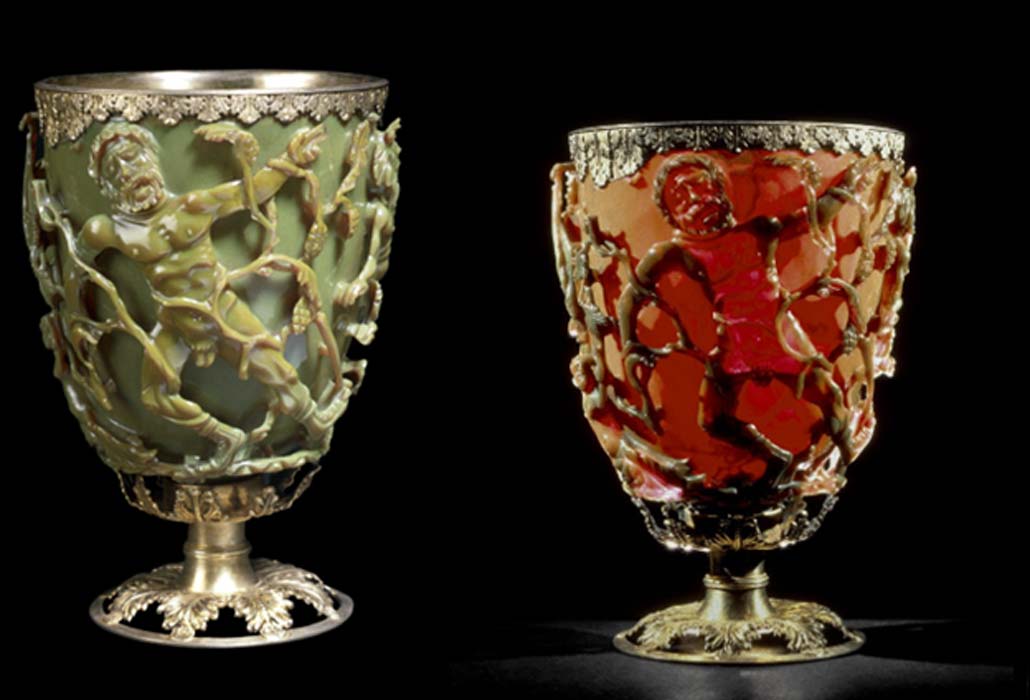Romans Mastered Nanotechnology and Used it for Eye Catching Decoration
A strange chalice made its way into the British Museum’s collection in the 1950s. It is a 1,600-year-old jade green Roman artifact called the Lycurgus Cup. The image on the chalice is an iconic scene with King Lycurgus of Thrace, but the element that sets this cup apart is the effect light has on it. If the cup is lit from the front it is jade green, but when it is lit from behind it glows blood red. At the time scientists were baffled by this stunning feature, they could not figure out how the Romans managed it – now we know.
The answer finally came to light in 1990. Researchers in England examined broken fragments of the glass under a microscope and discovered that the Roman artisan who made the chalice was a pioneer in nanotechnology. Teeny tiny particles of silver and gold were added to the glass – particles so small they were just 50 nanometers in diameter. That means these elements were less than one-thousandth the size of a grain of table salt.
- Built to Last: The Secret that Enabled Roman Roads to Withstand the Passage of Time
- More Evidence that Ancient Romans May Have Made It to Oak Island, Canada
- An Unbreakable Story: The Lost Roman Invention of Flexible Glass

Detail of the Roman glass when lit from behind. (The Trustees of the British Museum/CC BY NC SA 4.0)
You may scoff at the idea Romans planned for such a thing – but the work was precise and there is no way the effect happened by accident. The gold and silver particle mixture used in the chalice’s creation shows that ancient Romans had mastered some control over nanoparticles. Light makes the metal flecks in the glass vibrate in ways that change the chalice’s color depending on the view you have of the artifact. Archaeologist Ian Freestone of University College London applauded the Romans’ achievement as “an amazing feat.”

Another part of the scene on the Roman Lycurgus Cup. (The Trustees of the British Museum/CC BY NC SA 4.0)
Although the Romans used the technology as decoration, nanotechnology is being applied to other areas of life today. For example, it is used in diagnosing disease and detecting biohazards at security checkpoints. These days, scientists and engineers have noted that nanotechnology has an untapped potential. An engineer at the University of Illinois at Urbana-Champaign named Gang Logan Liu worked with colleagues to conduct a study on the reaction of gold and silver nanoparticles with a variety of solutions.
- Who Said Ancient People Had it Tough? Luxury Homes and Underfloor Heating Were a Part of Life in the Roman Province of Britannia
- Savoring the Danger: ‘Sugar of Lead’ Was Used to Flavor Roman Food and Wine with Toxic Consequences
- Researchers discover secret recipe of Roman concrete that allowed it to endure for over 2,000 years
They filled a plastic plate with nanoparticles of the two metals in a combination similar to what is seen in the Lycurgus Cup. Then the researchers mixed the particles with water, oil, sugar, or salt. Their results showed different color changes depending on which of the substances was mixed in. More exciting, they found that the prototype they created was 100 times more sensitive to salt levels than commercial sensors are today. The options are endless. Who knows? Maybe one day this prototype will be used in a handheld device to detect pathogens in saliva or urine samples. It may also have applications in helping security officials keep dangerous liquids off airplanes.

A solution containing different quantities of gold nanoparticles. (Aleksandar Kondinski/CC BY SA 4.0)
As you see, the Romans were far more advanced in some areas than most people would give them credit for. And the use of nanotechnology isn’t the only thing they have been able to beat us at. For example, scientists have discovered 2,000 year old Roman concrete under the waves of the Mediterranean Sea is superior to concrete available nowadays. Roman concrete surpasses the modern counterpart in durability and it is more environmentally friendly too. It seems that examining ancient technology may be the key to making the next big discovery!
Top Image: The Lycurgus Cup. Source: The Trustees of the British Museum/CC BY NC SA 4.0


















Comments
The thing about glass is that there are radiometric analysis techniques that can accurately confirm the date of creation. But they tend NOT to be used, as there is an obivous cost, and if pursued, the old theories might not be left standing. They find glass beads in Alaska and have to say that the Inuits brought them all the way from China, which is far-fetched. But here, the scene gives it away – it’s ancient Greek, not Roman. Probably pre-Ice Age, circa 120k plus BC, before the Atlantis event, during the hey-day of the earlier civilization that was destroyed/left to crumble/rust away to dust but for the bones, ceramics and non-ferrous objects, ...and of course the ruins, caverns and catacombs that were resettled.
Nobody gets paid to tell the truth.
Fortunately, this technology was invented and used not by the Romans, because it was completely other people. At that time, this people flourished, and the Romans were on the verge of extinction. This people saved Romans from death, but then, the Romans destroyed this nation almost completely. Like the Druids. That's how they rewarded. But the Romans paid very high price for it later - their empire was destroyed.